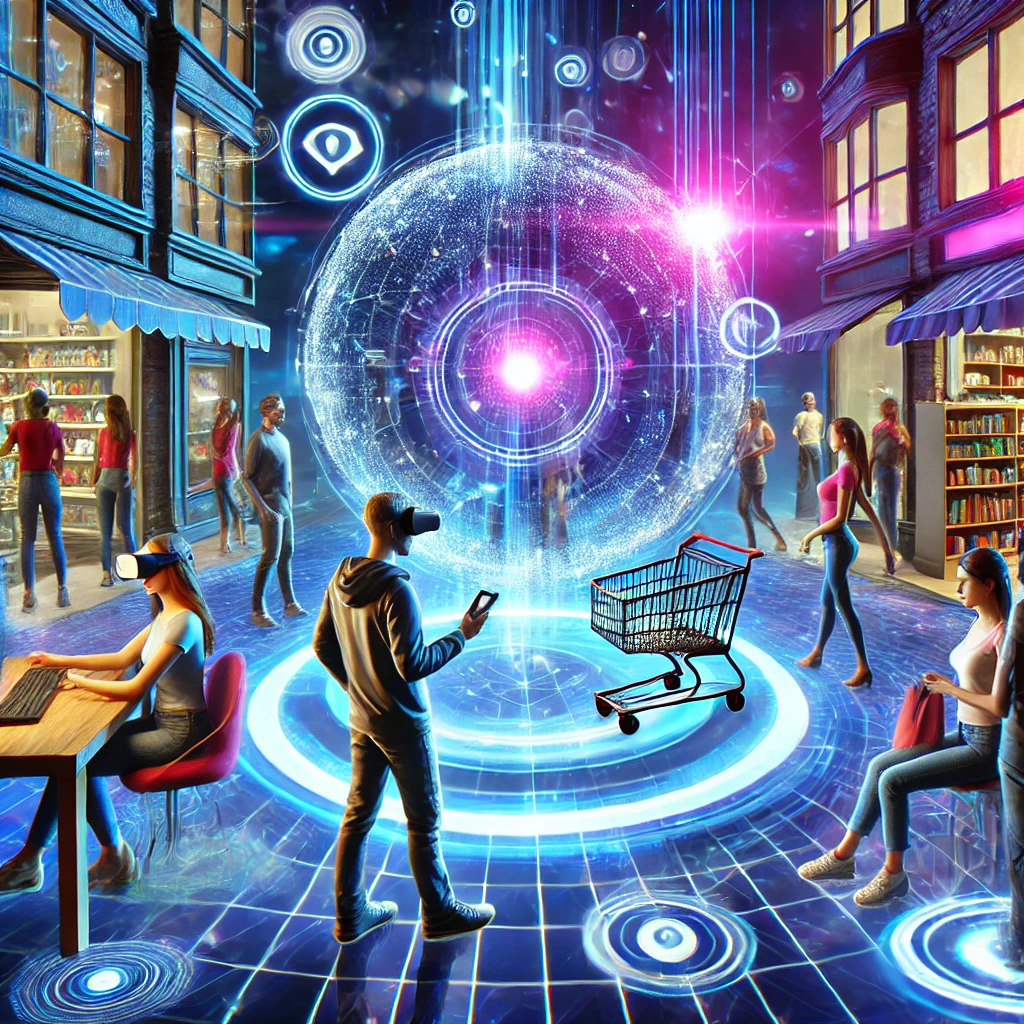The metaverse is an expansive digital universe where users can interact with each other and the environment in real-time, transcending physical limitations. Comprised of interconnected virtual worlds, the metaverse incorporates elements of augmented reality (AR), virtual reality (VR), and blockchain technology. This immersive ecosystem enables brands to create engaging experiences that resonate with consumers on a personal level.
How Does the Metaverse Work?
At its core, the metaverse functions through advanced technologies that allow for immersive interactions. Users can create digital avatars and explore virtual spaces that mimic the real world. Key technologies that power the metaverse include:
- Virtual Reality (VR): Fully immersive experiences using VR headsets.
- Augmented Reality (AR): Overlaying digital elements onto the physical world through smartphones or AR glasses.
- Blockchain: Decentralized platforms that ensure secure transactions and ownership of digital assets.
This amalgamation of technologies provides brands with the tools to engage customers dynamically, fostering deeper relationships and enhancing customer loyalty.
Transforming Customer Engagement
With the metaverse, brands can transform customer engagement in several impactful ways:
- Immersive Experiences: Brands can host virtual events, product launches, and interactive advertisements that captivate users.
- Personalization: Offering tailored experiences based on user behavior and preferences, leading to higher satisfaction rates.
- Community Building: The metaverse allows brands to cultivate communities where users can engage with one another, fostering brand loyalty.
- Real-time Interaction: Customers can interact with products and services in real-time, increasing the likelihood of conversion.
The metaverse presents an unparalleled opportunity for brands to redefine how they connect with customers, moving beyond traditional methods to create lasting impressions and meaningful interactions.
Key Strategies for Businesses to Enhance Customer Engagement in the Metaverse
The rise of the metaverse brings unique opportunities for businesses to engage with their customers in innovative ways. As companies explore this virtual frontier, implementing effective strategies becomes paramount. Here are some key approaches businesses can adopt to boost customer engagement.
1. Create Immersive Experiences
Customers are drawn to the metaverse for its immersive experiences. To capitalize on this trend, businesses should:
- Build Interactive Environments: Design virtual spaces that allow customers to interact, explore, and participate actively.
- Host Virtual Events: Organize live events such as product launches or customer appreciation parties that let users engage with the brand in a fun, memorable way.
- Leverage Virtual Reality (VR): Utilize VR technology to create engaging product demos and educational experiences that offer deeper insights into your offerings.
2. Foster Community Building
Creating a sense of community is essential in the metaverse. Here’s how businesses can achieve this:
- Incorporate Social Features: Enable chat rooms, discussions, and forums where customers can share experiences and feedback.
- Develop Loyalty Programs: Implement loyalty rewards for participation within the metaverse, encouraging customers to return and interact with your brand.
- Encourage User-Generated Content: Allow customers to create and share their own content related to your brand, enhancing engagement through personal investment.
3. Utilize Data Analytics for Personalized Experiences
Data plays a crucial role in understanding customer behavior and preferences in the metaverse. Businesses should:
- Gather Insights: Use analytics tools to track user interactions and preferences, adapting experiences to meet customer needs.
- Personalize Content: Tailor marketing messages, promotions, and virtual experiences based on individual customer insights.
- Test and Optimize: Regularly assess engagement strategies and refine them based on analytics to ensure they resonate with the target audience.
4. Collaborate with Influencers
[aib_post_related url=’/virtual-reality-meetings-in-the-metaverse/’ title=’Virtual reality meetings in the Metaverse’ relatedtext=’Quizás también te interese:’]
Engaging with influencers can amplify brand visibility in the metaverse. Strategies include:
- Partnering with Virtual Influencers: Collaborate with avatars that have established followings in the metaverse.
- Encouraging Co-Creation: Involve influencers in the creation of branded virtual goods, which can attract their audience.
- Utilizing Mixed Media Content: Leverage various content forms like live streams and VR interactions featuring influencers to captivate audiences.
How the Metaverse Fosters Interactive and Immersive Customer Experiences
The Metaverse is not just a futuristic concept; it’s fast becoming a transformative platform for businesses aiming to enhance their customer experiences. By integrating augmented reality (AR) and virtual reality (VR), brands are creating virtual environments where consumers can interact in real-time. This engagement fosters a sense of presence that static websites or traditional shopping cannot provide. In this immersive digital arena, customers can explore products, participate in virtual events, and communicate with others, leading to richer interactions.
What Are the Key Features of Customer Experiences in the Metaverse?
- Real-Time Interaction: Customers can engage with brands instantly through avatars, providing a personalized touch.
- Virtual Showrooms: Brands like Nike and Gucci are already creating virtual spaces where customers can try on products digitally.
- Gamification: Engaging customers through games enhances their interaction and retention.
- Social Connectivity: The metaverse allows users to shop alongside friends or other users, enriching the experience.
How Do Brands Utilize the Metaverse for Customer Engagement?
Brands are leveraging the Metaverse to host digital events and launch innovative marketing campaigns. For instance, Ford held a virtual launch for a new vehicle, allowing potential customers to interactively explore its features. Similarly, Gucci hosted a virtual party in a digital world, drawing in thousands of participants who could explore the brand’s offerings while socializing. This immersion does not only capture consumer attention; it promotes deeper emotional connections to the brand through shared experiences.
What Benefits Do Customers Gain from the Metaverse Experience?
Customers benefit greatly from the immersive nature of the Metaverse, which offers personalization and accessibility. They can customize their avatars and tailor their shopping experiences based on their preferences. Additionally, 24/7 availability ensures that customers can explore brand offerings at their convenience, breaking the traditional boundaries of physical store hours. This level of accessibility opens opportunities for more consumers, particularly those who may have physical limitations or live in remote areas.
Case Studies: Successful Brands Leveraging the Metaverse for Customer Engagement
The metaverse has emerged as a significant channel for brands aiming to enhance customer engagement. Companies are exploring immersive experiences using virtual and augmented realities to interact with their audiences. Below are notable case studies showcasing how successful brands are capitalizing on this digital frontier.
1. Nike: Pushing the Boundaries of Digital Interaction
Nike has effectively utilized the metaverse through its virtual world experiences. The brand launched a virtual store in the game Roblox, allowing players to try on and purchase digital shoes and apparel. This initiative not only broadened Nike’s customer base among younger audiences but also integrated an engaging shopping experience that mirrors the real-world process. Notably, the brand reported a substantial uptick in community engagement and sales, demonstrating the potential of virtual commerce.
2. Gucci: Establishing Virtual Iconography
Gucci ventured into the metaverse with the introduction of a digital fashion line in the platform Roblox. Users can purchase unique virtual outfits for their avatars, thereby placing the brand directly at the forefront of fashion in a digital ecosystem. By collaborating with influential game developers, Gucci reinforced its position as a luxury brand while engaging a younger, tech-savvy audience. Their strategy exemplifies how luxury brands can adopt digital innovation to stay relevant and appealing.
3. Coca-Cola: Crafting Memorable Experiences
Coca-Cola embraced the metaverse by launching a virtual reality experience that allows users to explore the history and legacy of the brand in an interactive way. This initiative brought consumers closer to the brand story while creating a platform for users to connect with others through shared experiences. The success of this campaign highlights a growing trend in the metaverse: the emphasis on storytelling and community engagement as vital elements of customer connection.
[aib_post_related url=’/metaverso-y-simulacion-de-negocios/’ title=’Metaverso y simulación de negocios’ relatedtext=’Quizás también te interese:’]
4. Adidas: Engaging Through Digital Collectibles
Adidas took a unique approach by tapping into the world of non-fungible tokens (NFTs). The brand launched a limited collection of digital sneakers, providing an exclusive experience to collectors and fans. This strategy not only generated buzz but also allowed Adidas to engage directly with its most loyal consumers, establishing a new model for brand loyalty in the metaverse. The integration of blockchain technology in their strategy demonstrates a forward-thinking approach to customer engagement.
These case studies illustrate that the metaverse is not just a trend but a transformative space that brands can leverage for deeper consumer relationships. By embracing innovation and using interactive elements, brands like Nike, Gucci, Coca-Cola, and Adidas are setting the stage for successful customer engagement in the digital age.
Future Trends: The Evolution of Customer Engagement in the Metaverse
The concept of the metaverse is transforming the way customers interact with brands. As technology evolves, businesses are discovering new avenues for engagement that blend physical and virtual experiences. With platforms like Meta and Roblox leading the charge, brands are beginning to establish their presence in these immersive environments.
Enhanced Personalization through AI and Avatars
In the metaverse, customer engagement is increasingly becoming personalized through the use of artificial intelligence (AI) and customizable avatars. Brands can leverage data analytics to understand consumer preferences better and create tailored experiences. Here are some examples of how personalization is enhancing customer engagement:
- Customized Avatars: Users can create avatars that mirror their real-life appearances and preferences, making interactions feel more authentic.
- Targeted Offers: Brands can provide specific promotions based on a user’s habits, ensuring that customers receive relevant offers as they navigate the virtual world.
- Immersive Experiences: Personalized environments can be designed for users, allowing them to interact with products in a way that reflects their unique tastes.
Community Building in Virtual Spaces
The metaverse is fostering community-driven interactions, where customers not only engage with brands but also with each other. This shift is reshaping the customer experience into a more collaborative and social endeavor. Here are some future trends in community building:
- Virtual Events: Brands are hosting live events in the metaverse, allowing customers to gather and interact in real-time regardless of geographical barriers.
- Social Commerce: Collaborative shopping experiences where users can shop together in virtual environments, sharing opinions and recommendations.
- Brand Loyalty Programs: Innovative loyalty programs that reward customers not just for purchases, but for their social interactions within the brand’s virtual spaces.
Integration of Augmented Reality (AR) and Virtual Reality (VR)
The integration of AR and VR technologies is another pivotal trend in customer engagement within the metaverse. These technologies offer customers immersive and tactile experiences that enhance brand interaction:
- Virtual Try-Ons: Brands in the fashion industry are using AR to let customers try on clothes or accessories virtually, improving confidence in purchasing decisions.
- Interactive Product Demos: Companies can provide virtual demonstrations of their products, allowing customers to interact with and understand the product’s benefits in detail.
- Gamification: Adding a gaming dimension to shopping can increase user engagement, making the brand experience more enjoyable and memorable.
[aib_post_related url=’/metaverse-corporate-training-facilities/’ title=’Metaverse corporate training facilities’ relatedtext=’Quizás también te interese:’]
As we move further into the era of the metaverse, these trends will shape how brands engage with customers. The future holds exciting possibilities for creating immersive, personalized, and community-oriented experiences that redefine customer engagement as we know it.


